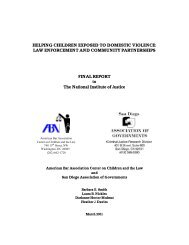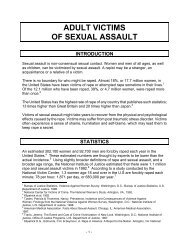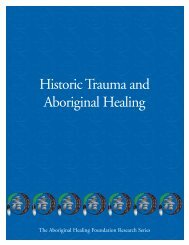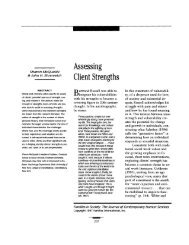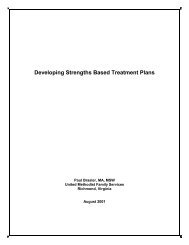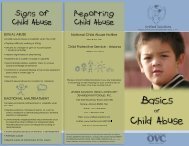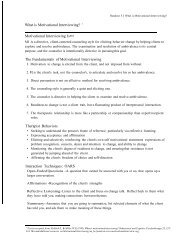Understanding Child Maltreatment, CDC Fact Sheet 2006
Understanding Child Maltreatment, CDC Fact Sheet 2006
Understanding Child Maltreatment, CDC Fact Sheet 2006
You also want an ePaper? Increase the reach of your titles
YUMPU automatically turns print PDFs into web optimized ePapers that Google loves.
<strong>Understanding</strong><br />
<strong>Child</strong> <strong>Maltreatment</strong><br />
<strong>Fact</strong> <strong>Sheet</strong> <strong>2006</strong><br />
<strong>Child</strong> maltreatment includes all types of abuse and<br />
neglect that occur among children under the age of 18.<br />
There are four common types of abuse.<br />
• Physical abuse occurs when a child’s body is injured<br />
as a result of hitting, kicking, shaking, burning or<br />
other show of force.<br />
• Sexual abuse involves engaging a child in sexual acts.<br />
It includes fondling, rape, and exposing a child to<br />
other sexual activities.<br />
• Emotional abuse refers to behaviors that harm a<br />
child’s self-worth or emotional well-being. Examples<br />
include name calling, shaming, rejection, withholding<br />
love, and threatening.<br />
• Neglect is the failure to meet a child’s basic needs.<br />
These needs include housing, food, clothing,<br />
education and access to medical care.<br />
Why is child maltreatment a<br />
public health problem?<br />
The few cases of abuse or neglect we see in the news<br />
are only a small part of the problem. Many cases<br />
are not reported to police or social services. What we<br />
do know is that:<br />
• 1,490 children died in the United States in 2004 from<br />
abuse and neglect. 1<br />
• 872,000 children were identified as being maltreated<br />
by social service agencies in 2004. 1<br />
• Each year, legal and health care costs for child<br />
maltreatment exceed $24 billion. 2<br />
How does child maltreatment<br />
affect health?<br />
<strong>Child</strong> maltreatment has a negative effect on health.<br />
Abused children often suffer physical injuries including<br />
cuts, bruises, burns and broken bones. In addition,<br />
maltreatment causes stress that can disrupt early brain<br />
development. 3 Extreme stress can harm the<br />
development of the nervous and immune systems. 3 As<br />
a result, children who are abused or neglected are at<br />
higher risk for health problems as adults. These<br />
problems include alcoholism, depression, drug abuse,<br />
eating disorders, obesity, sexual promiscuity, smoking,<br />
suicide, and certain chronic diseases. 4,5<br />
Who is at risk for child<br />
maltreatment?<br />
<strong>Child</strong>ren are never to blame for the harm others do to<br />
them. However, some factors can increase the risk of a<br />
child being abused. The presence of these factors does<br />
not always mean that abuse will occur.<br />
Age. <strong>Child</strong>ren under 4 years of age are at greatest risk<br />
for severe injury and death from abuse.<br />
Family environment. Abuse and neglect can occur in<br />
families where there is a great deal of stress. The stress<br />
can result from a family history of violence, drug or<br />
alcohol abuse, poverty, and chronic health problems.<br />
Families that do not have nearby friends, relatives, and<br />
other social support are also at risk.<br />
Community. On-going violence in the community<br />
may create an environment where child abuse is<br />
accepted.<br />
www.cdc.gov/injury
<strong>Understanding</strong> <strong>Child</strong> <strong>Maltreatment</strong><br />
How can we prevent<br />
child maltreatment?<br />
The ultimate goal is to stop child maltreatment before<br />
it starts. Strategies that support parents and teach<br />
positive parenting skills are very important. Positive<br />
parenting skills include good communication,<br />
appropriate discipline, and responding to children’s<br />
physical and emotional needs. Programs to prevent<br />
child maltreatment also improve parent-child<br />
relationships and provide parents with social support.<br />
Programs for parents can take many different forms.<br />
They may occur in parents’ homes, in schools, in<br />
medical or mental health clinics, or in other community<br />
settings. Programs may involve one-on-one or group<br />
sessions.<br />
How does <strong>CDC</strong> approach<br />
prevention?<br />
<strong>CDC</strong> uses a 4-step approach to address public health<br />
problems like child maltreatment.<br />
Step 1: Define the problem<br />
Before we can prevent child maltreatment, we need to<br />
know how big the problem is, where it is, and whom it<br />
affects. <strong>CDC</strong> learns about a problem by gathering and<br />
studying data. These data are critical because they help<br />
decision makers send resources where they are needed<br />
most.<br />
Step 2: Identify risk and protective factors<br />
It is not enough to know that child maltreatment is<br />
affecting a certain group of children in a certain area.<br />
We also need to know why. <strong>CDC</strong> conducts and<br />
supports research to answer this question. We can then<br />
develop programs to reduce or get rid of risk factors.<br />
Step 3: Develop and test prevention strategies<br />
Using information gathered in research, <strong>CDC</strong> develops<br />
and evaluates strategies to prevent child maltreatment.<br />
Step 4: Ensure widespread adoption<br />
In this final step, <strong>CDC</strong> shares the best prevention<br />
strategies. <strong>CDC</strong> may also provide funding or technical<br />
help so communities can adopt these strategies.<br />
For a list of <strong>CDC</strong> activities, see Preventing <strong>Child</strong><br />
<strong>Maltreatment</strong>: Program Activities Guide (www.cdc.gov/<br />
ncipc/dvp/pcmguide.htm).<br />
Where can I learn more?<br />
To report abuse or get help, contact the National <strong>Child</strong><br />
Abuse Hotline at 1-800-4-A-CHILD (1-800-422-4453).<br />
Centers for Disease Control and Prevention<br />
www.cdc.gov/injury<br />
Administration for <strong>Child</strong>ren and Families<br />
www.acfhhs.gov/programs/cb<br />
<strong>Child</strong> Welfare Information Gateway<br />
www.childwelfare.gov<br />
National Scientific Council on the Developing <strong>Child</strong><br />
www.developingchild.net<br />
Prevent <strong>Child</strong> Abuse America<br />
www.preventchildabuse.org<br />
References<br />
1. Department of Health and Human Services, Administration on <strong>Child</strong>ren,<br />
Youth, and Families. <strong>Child</strong> <strong>Maltreatment</strong> 2004 [online]. Washington (DC):<br />
Government Printing Office; <strong>2006</strong>. [cited <strong>2006</strong> Jul 19]. Available from: http://<br />
www.acf.hhs.gov/programs/cb/pubs/cm04/index.htm.<br />
2. Fromm S. Total estimated cost of child abuse and neglect in the United<br />
States—statistical evidence. Chicago (IL): Prevent <strong>Child</strong> Abuse America<br />
(PCAA); 2001. [cited 2005 Jan 1]. Available from: www.preventchildabuse.org/<br />
learn_more/research_docs/cost_analysis.pdf.<br />
3. National Scientific Council on the Developing <strong>Child</strong>. Excessive stress disrupts<br />
the architecture of the developing brain, Working Paper No. 3 [online]. 2005<br />
[cited <strong>2006</strong> Jan 31]. Available from: www.developingchild.net/reports.shtml.<br />
4. Felitti V, Anda R, Nordenberg D, Williamson D, Spitz A, Edwards V, et al.<br />
Relationship of childhood abuse and household dysfunction to many of the<br />
leading causes of death in adults. American Journal of Preventive Medicine.<br />
1998;14(4):245–58.<br />
5. Runyan D, Wattam C, Ikeda R, Hassan F, Ramiro L. <strong>Child</strong> abuse and neglect by<br />
parents and caregivers. In: Krug E, Dahlberg LL, Mercy JA, Zwi AB, Lozano R,<br />
editors. World Report on Violence and Health. Geneva, Switzerland: World<br />
Health Organization; 2002. p. 59–86.<br />
For more information, please contact:<br />
Centers for Disease Control and Prevention<br />
National Center for Injury Prevention and Control<br />
1-800-<strong>CDC</strong>-INFO • www.cdc.gov/injury • cdcinfo@cdc.gov




